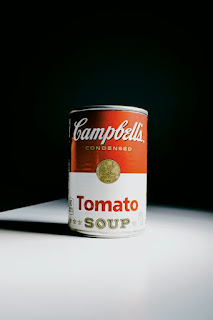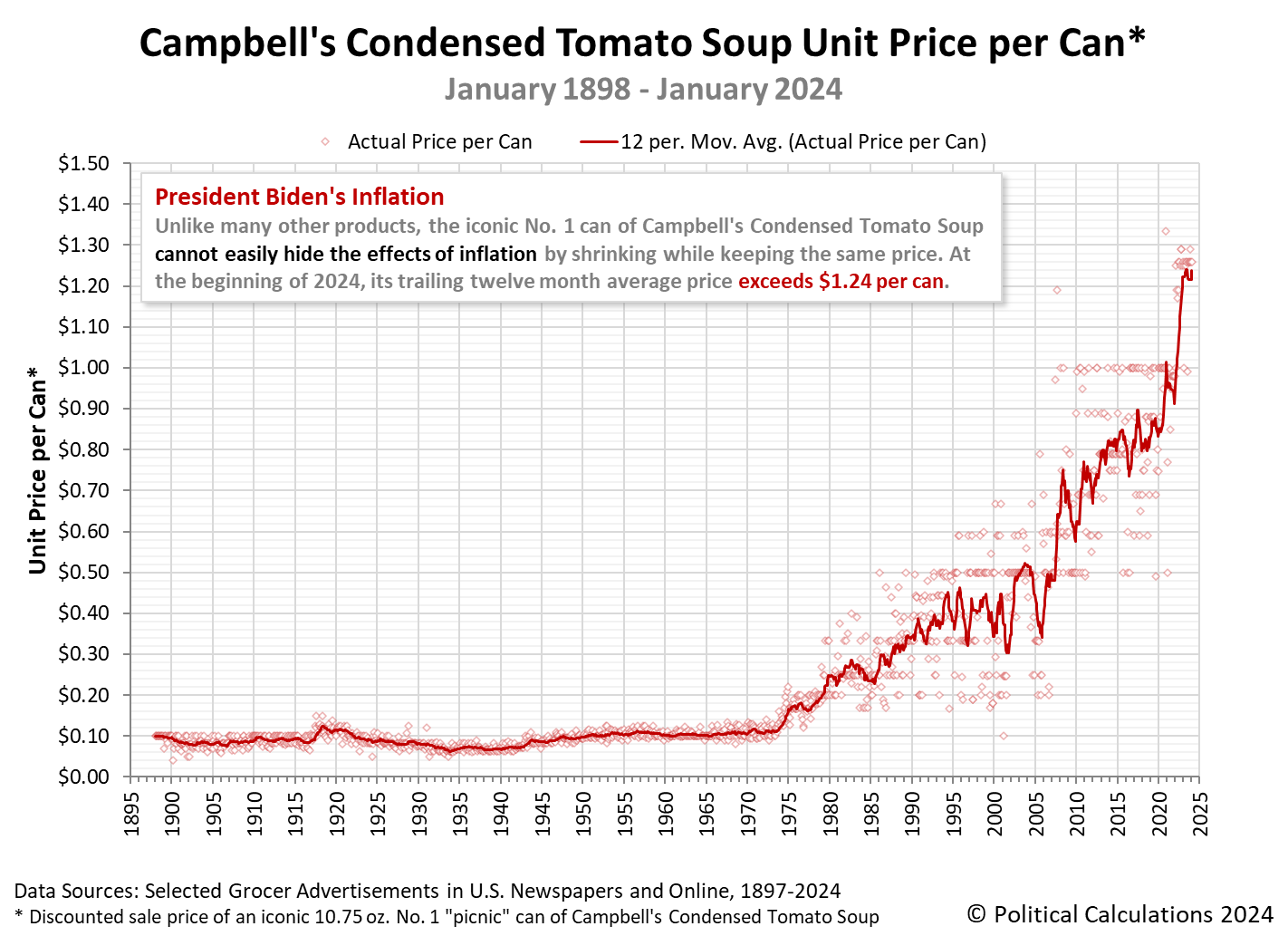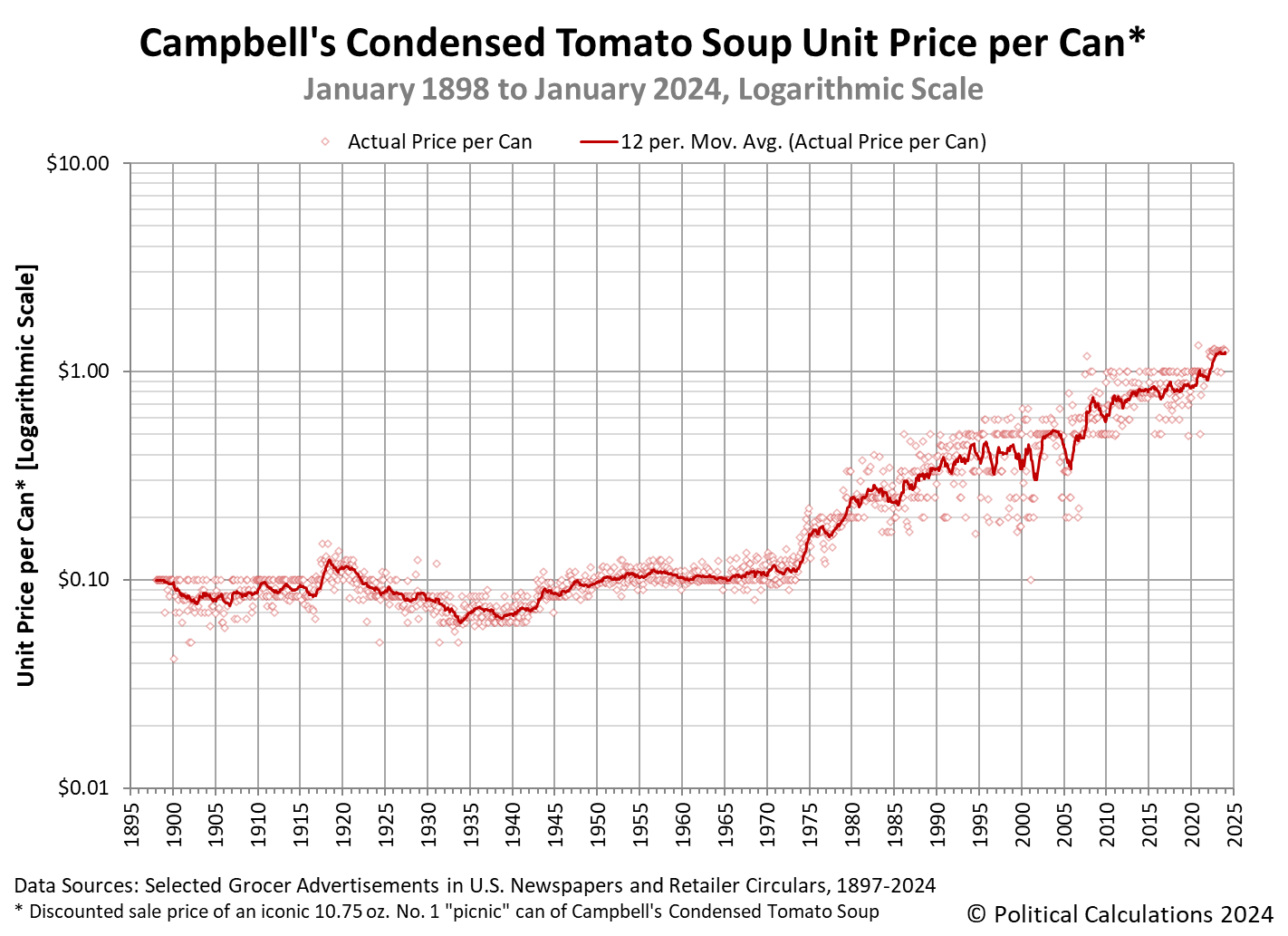You can learn a lot about inflation by paying attention to how much a can of Campbell's Condensed Tomato Soup costs at your local grocery store.
To understand why requires some background. 2024 marks the product's 127th anniversary. First introduced to American consumers by Campbell Soup (NYSE: CPB) in 1898 after John Dorrance developed it the year before, it now ranks as the company's second-most popular soup. Campbell Soup sells an estimated 85 million cans of its condensed tomato soup each year, which works out to be a little under one out of every five cans of soup the company sells. Only the company's Chicken Noodle soup outsells it with annual sales of more than 250 million cans, accounting for almost 57% of the company's total soup sales.
With such big numbers involved, the Campbell Soup's second-biggest selling product can't help but be affected by economic forces at work within the United States' economy. In the last two years, inflation has been a major force within the economy, increasing the prices of millions of goods that Americans buy.
What makes Campbell's Condensed Tomato Soup especially useful for seeing the effects of inflation is its remarkable consistency as an identifiable product over time. If you had a time machine and could travel to nearly any point in time from January 1898 to the present, you could likely find a Number 1 (10.75 oz) can of Campbell's condensed tomato soup stocked for sale in hundreds of grocery stores all across the country. That long-running consistency makes Campbell's Condensed Tomato Soup an ideal product to follow to understand inflation because it's very difficult to subject to marketing tricks like "shrinkflation", in which producers try to hide how much more it costs consumers to buy their goods by putting less of their products into the same size packaging but continuing to charge the same price as before they monkeyed with them.
Campbell's iconic cans of condensed tomato soup cannot easily hide the increased costs of everything that goes into making them. Whether its the cost of tomatoes, spices, steel for the cans, paper and ink for the labels, energy to produce, oil to transport, and of course labor at every level of its production. Because it cannot easily change this popular product, the price consumers pay for a can of Campbell's condensed tomato will capture most, if not all, the costs that go into making it at every level of its production.
Political Calculations has created a record of the typical price Americans have paid for a single iconic can of Campbell's Condensed Tomato Soup in each month since January 1898 by going through more than 12 decades worth of archived newspapers and advertising circulars to identify the prices at which grocers have put them on sale. Today we're updating that price history in our chart visualizing that history from January 1898 through January 2024.
For the latest in our coverage of Campbell's Tomato Soup prices, follow this link!
In January 2024, we find the prevailing average sale price for this food product over the past 12 months is $1.24 per can, as its price has stabilized since inflation was unleashed in March 2021. This figure has risen by a little over 30% from the trailing 12 month average of $0.95 per can we recorded in January 2022.
During this time, we've seen discounted sales of Campbell's Condensed Tomato Soup become both smaller and less frequent. Before March 2021, which marks Month 0 for when President Biden's inflation got started, it was rare to see the regular sale price of a can of Campbell's Condensed Tomato Soup above one dollar. In January 2024, that's now the lowest price at which American consumers can expect to pay for a can when they find it at a deeply discounted sale price.
Here's the January 2024 update for our periodic sampling of Campbell's Condensed Tomato Soup sale prices at 10 major U.S. grocery-selling retailers, where we're indicated the change in price since our last update in October 2023. Several prices have bounced around as various grocers have offered or removed short-term discounts to their customers, but have mostly been steady:
- Walmart: $1.26/each, unchanged
- Amazon: $1.99/each, increase of $0.40 (+25.2%)
- Kroger: $1.29/each, increase of $0.29 (29%)
- Walgreens: $1.99/each, unchanged or $1.50/each when you buy two cans
- Target: $1.39/each, unchanged
- CVS: $1.89/each, decrease of $0.20 (-9.6%)
- Albertsons: $1.49/each, decrease of $0.20 (-11.8%)
- Food Lion: $1.25/each, unchanged
- H-E-B: $1.31/each, unchanged
- Meijer: $1.29/each, unchanged
Campbell's Condensed Tomato Soup costs about 12.5 times more than the original price American grocery shoppers paid when Campbell's began selling their just-invented condensed soup products in 1898. Because its price history now spans more than a full order of magnitude, showing the price history in logarithmic scale gives a better sense of how much and when inflation has affected the prices American consumers pay for a can of Campbell's Condensed Tomato Soup.
The escalation of Campbell's Condensed Tomato Soup since March 2021 is generally consistent with how food prices have generally changed over this time:
Americans are furious as they continue to get crushed by high grocery store bills despite inflation nearing pre-COVID levels, according to a new survey.
The latest Axio Vibe Check survey of 2,120 adults in December revealed that about 72% of respondents felt inflation was still hitting hard at the grocery store....
Overall, the category of “food at home prices” rose 1.3% for 2023, a seemingly small number but one that comes after years of high costs and a high of 13.5% in August.
This means that Americans who spent $100 on their grocery bills in 2019 would be spending about $125.51 on the same amount of food in December, according to data from the BLS.
This shows that Americans are still spending more than 21% on their grocery bills than they were before the pandemic, a clear indication that inflation remains a sore subject for most consumers, according to the Axio survey.
Campbell's Condensed Tomato Soup is on the higher end of that average. At the beginning of 2024, the most important thing to note about its price is that it is not falling.
Previously on Political Calculations
Political Calculations' analysis of Campbell's Tomato Soup dates back to 2015! Along the way, we've filled in the gaps we had in the historic price data and have explored America's second-most popular soup from a lot of different angles.
- The Price of Campbell's Tomato Soup Since 1897 (2015)
- The Tomato Soup Standard (2015)
- The First Ad Ever for Campbell's Condensed Tomato Soup (2015)
- War and Soup (2015)
- Working Backwards from Retail to Cost (2015)
- Early Advertising Milestones for Campbell's Condensed Soups
- Updated: The Price of Campbell's Tomato Soup Since 1897 (2016)
- Everyday Low Prices (2017)
- Soup and Recession (2017)
- Soup and Steel Tariffs (2018)
- Tomato Soup, Oil and Inflation (2018)
- Celebrating 150 Years of the Campbell's Soup Company (2019)
- The Price History of Campbell's Tomato Soup (2020)
- Campbell's Tomato Soup Sales Soar as Americans prep for Home Quarantines (2020)
- Campbell's Soup Presents "The Magic Shelf" (2020)
- The Price of Campbell's Tomato Soup in the Coronavirus Pandemic (2021)
- The Pandemic Price Escalation of Campbell's Tomato Soup (2021)
- Shrinkflation and a New Tool to Track Price Inflation in Real Time (2021)
- Absence of Discounts Confirms Tomato Soup Inflation (2021)
- The Ship of Theseus and Campbell's Tomato Soup (2021)
- The S&P 500 and Campbell's Tomato Soup (2021)
- Upward Price Pressure at the Start of Soup Season (2021)
- Recent Price Trends for Campbell's Tomato Soup (2021)
- The Price History of Campbell's Tomato Soup (2022)
- Campbell's Tomato Soup Prices Explode Higher (2022)
- Major Grocers Continue Hiking Tomato Soup Prices (2022)
- Campbell's Tomato Soup Prices Keep Escalating (2022)
- Campbell's Soup to See Third Wave of Price Increases (2022)
- Amazon Hikes Campbell's Tomato Soup Prices (2022)
- Cost of Campbell's Tomato Soup Keeps Rising (2022)
- The Price History of Campbell's Tomato Soup (2023)
- Inflation Slows for Campbell's Tomato Soup (2023)
- Campbell's Tomato Soup Prices Stabilizing at Inflated Level (2023)
- The Price History of Campbell's Tomato Soup (2024)
Image credit: Campbells tomato soup can photo by Girl with red hat on Unsplash.
Welcome to the blogosphere's toolchest! Here, unlike other blogs dedicated to analyzing current events, we create easy-to-use, simple tools to do the math related to them so you can get in on the action too! If you would like to learn more about these tools, or if you would like to contribute ideas to develop for this blog, please e-mail us at:
ironman at politicalcalculations
Thanks in advance!
Closing values for previous trading day.
This site is primarily powered by:
CSS Validation
RSS Site Feed
JavaScript
The tools on this site are built using JavaScript. If you would like to learn more, one of the best free resources on the web is available at W3Schools.com.


